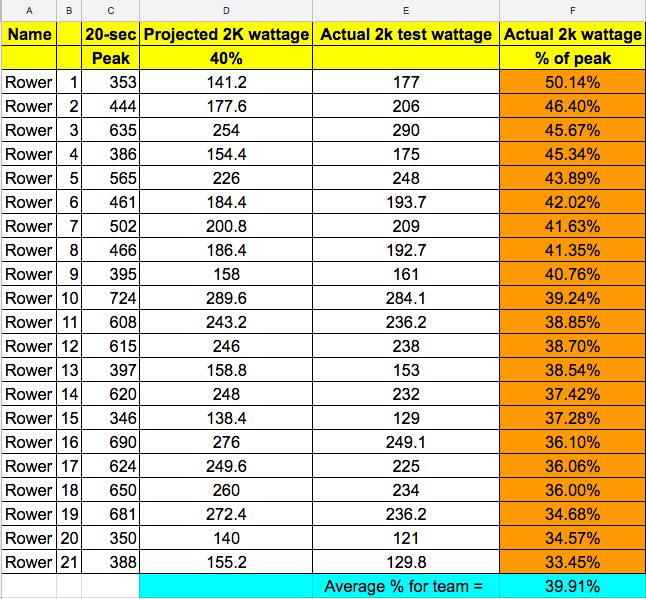I’m not a great believer in predictions, especially when it comes to human effort.
There’s too many variables that come into play.
Yet, I sincerely believe in “edu-guessing” (making educated guesses) that get close to reality.
That holds true when trying to a predict a team’s 2k erg scores.
How to predict a team’s 2k erg score in 20 seconds
I use a fairly simple system to edu-guess my team’s 2K erg scores. Over the years I’ve found it to be fairly accurate.
What “fairly accurate” means is that I can, within a reasonable margin predict what a team’s 2k erg score will be. And it’s based on a simple 20-second erg piece.
Here’s what I do, and an example:
Get 20-second wattage score
- Set up erg (I use Concept2) for rowers, with damper on highest setting (“10”).
- Divide team into teams of 2.
- Athletes do a moderate warm up, not extensive.
- After warm up, make sure flywheel has stopped spinning
- Set screen for 20-second countdown, use unit of “watts.”
- Have partner watch screen, looking for the highest peak-wattage during the 20-second piece.
- Start piece, rower using full stroke, with aggressive rating and pressure, tries for highest wattage attainable.
- Partner records the peak-wattage. Then switch on erg to row next piece.
- Athletes can do several more pieces, just make sure wheel has come to full stop before starting. I have found that 3 pieces seem to be the magic number.
Now figure the team’s 2k erg score
Once you have the highest of the peak-wattages, do a wee bit of math:
20-second peak-wattage x “percentage” = projected 2k wattage
That’s the science, now for the art — figuring out what the “percentage” is.
Over the years, I settled on the follow percentages:
- 40% juniors
- 42% collegiate
- >44% elite
An example of how to predict 2k erg score for a team
My current team (juniors) recently went through this process. Here are the results:

You can see that the actual percentages (column F) ranged from 50.14% to 33.45%. That’s a fairly big swing. However, the team average was just at 39.91%. Which aligns with my 40% average for juniors.
Why try to predict 2k erg score?
Yeah, why do this besides to overwhelm you (and your team) with numbers? Good question. Here are 3 reasons I do it:
- Gives me a holistic view of team performance.
- Helps me figure out what questions I should be asking. Why was Rower #1’s percent > 50%, while Rower #21’s percent was 33.45%? That’s a good question to ask, and that’s what this system really helps with…asking good questions. The system does NOT help me to precisely predict a specific rower’s score. But it does help me see things, team wise, that might be worth looking at in detail.
- Keeps an eye on the training plan. Huge swings, like we had between #1 and #21 could indicate issues, such as a team illness, or a faulty training plan.
A big fat disclaimer
Here’s the deal, this system, and these percentages might not work at all for you. In fact, I’m not saying what works for me is generalizable to anyone else. And here are a few issues to be aware of:
- As presented, this is NOT a good system for predicting an individual’s specific erg score. It can give you a range, but not a specific score.
- It uses the units of watts, instead of pace (500m splits), and most rowers seem to prefer pace. (It’s a simple process of converting watts to pace by using this calculator.)
- This system assumes a reasonable ability of the rower, per technique and conditioning.
I developed this system by melding info from Ed McNeely, testing that other coaches performed, seeing other systems, and over the years learning what worked for me. I’m sharing this system because I believe that having systems, like this one, that works for you/your situation, can make your training and testing more interesting. Productive. More successful.
Mike Davenport is the author of MaxRigging – a website dedicated to rowing, rigging and is the author of the Nuts and Bolts Guide to Rigging 
Resources for coaches around Testing and Selection
- Prognostic times for rowing ebook – how to set them and predict likely race (on water) times
- Ergometer testing for rowers ebook – how to prepare your body and mind, a race plan, what to do before and after the test
- Indoor and outdoor rowing apps – Written for World Rowing by Rebecca Caroe







This Post Has One Comment
Quite interesting! And in my opinion this method gives a stron recommendation for training maximum strength in the muscules that are important for rowing. (Quads, gludeus maximus, hamstrings, back, shoulders,…) If I can raise my general strength, i can raise my rowings-specific strength too(and so the forceproduction for one stroke) and so I will get even better 2k scores.
But still you will need to train VO2max, aerobic-streshhold, anaerobic capacity, to ‘bring it home’ over an 6-8min effort. This propably divides the ~50% guy from the 33% guy.